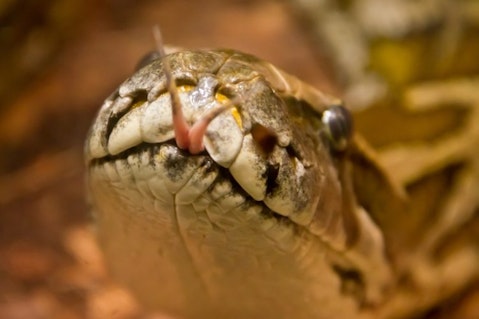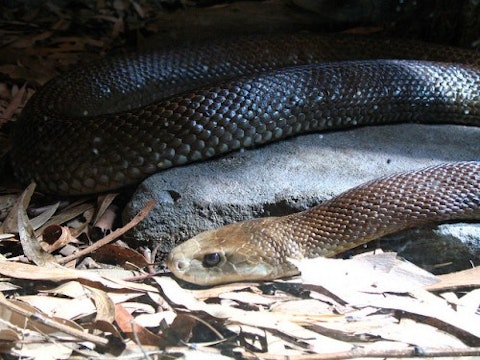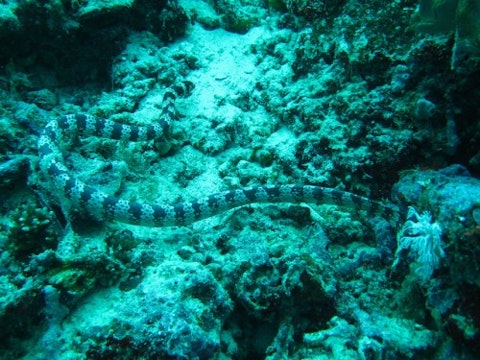Below you can find the list of the top 10 most deadliest and dangerous snakes in the world. For a detailed coverage of this topic and a more comprehensive list, please see the 20 most deadliest and dangerous snakes in the world.
10. Gaboon viper (Bitis gabonica)
Subcutaneous LD50 (Mg/kg): 0.144
Venom Yield/Bite (Mg): 350.0-600.0
Distribution: Africa
Although it’s among the most deadliest snakes in the world, it rarely bites humans as it is not an aggressive species. It mainly lives in the rainforest areas. Gaboon vipers are not willing to move, even if you approach them. They generally bite when somebody steps on them accidentally. They can inject large portion of venom into the victim’s body. There are records saying their venom yield can reach even 1000 mg/bite. A study written by Marsh and Whaler in 1994 mentioned a venom yield of 9.7 mL of wet venom, which means 2,400 mg of dried venom. Symptoms of this snake’s bite include severe shock, hypotension, dyspnoea, heart damage and internal bleeding.

mat.hak/Shutterstock.com
9. Puff adder (Bitis arietans)
Subcutaneous LD50 (Mg/kg): 0.142
Venom Yield/Bite (Mg): 100.0-350.0
Distribution: Africa
Puff adder ranks 9th on the list of top 10 most deadliest and dangerous snakes in the world. This snake is responsible for the most snakebites and death cases in Africa. What makes this snake so deadly? Its common occurrence, wide distribution, strong venom, large size, as well as its huge, long fangs. 100 mg of this venom is enough to kill a grown adult within a day. Symptoms include nausea and vomiting, edema, gangrene, hypotension. The mortality rate is around 52%.

Pixabay/Public domain
8. Tiger snake (Notechis scutatus)
Subcutaneous LD50 (Mg/kg): 0.118
Venom Yield/Bite (Mg): 35.0-189.0
Distribution: Australia
Tiger snakes were responsible for 17% of reported and identified snakebites in Australia between 2005 and 2015. 4 out of 119 victims ended up dead. After being bitten, victims can feel tingling, sweating, numbness, followed by difficulties in breathing and paralysis. Mortality rate is between 40%-60%.

jokerbethyname/Shutterstock.com
7. Black-banded sea krait (Laticauda semifasciata)
Subcutaneous LD50 (Mg/kg): 0.111
Venom Yield/Bite (Mg): 2.0-14.0
Distribution: Fiji, Japan, Singapore
Black-banded sea krait stands on the seventh spot of the most deadliest and dangerous snakes in the world. Its habitat is in coral reef areas. It breathes air, so it needs to come up to surface of the water at least every six hours. Resting fish seeking shelter in coral reefs are its food. Its venom is ten times stronger than that of a cobra, which shows how dangerous the black-banded sea krait is. Nevertheless, if not provoked by humans, it doesn’t attack.

poorbike/Shutterstock.com
6. Many-banded krait (Bungarus multicinctus)
Subcutaneous LD50 (Mg/kg): 0.108
Venom Yield/Bite (Mg): 8.0-20.0
Distribution: China, Southeast Asia
Immediately after this snake’s bite, there are almost no symptoms. The victim can experience only some mild numb and itchy feeling. But after 5-6 hours, severe symptoms start to emerge, such as general ache, ataxia, loss of voice, glossolysis (paralysis of the tongue), difficulties in breathing, among others. Estimated mortality is between 35%-100%. During the Vietnam War, American soldiers called this snake the “two-step snake.”

5. Coastal taipan (Oxyuranus scutellatus)
Subcutaneous LD50 (Mg/kg): 0.099
Venom Yield/Bite (Mg): 120
Distribution: Australia, New Guinea
Coastal taipan is the ranks 5th on the list of 20 most deadliest and dangerous snakes in the world. This snake’s fangs are extremely strong and produce neurotoxin which influences the nervous system. The victim can feel nausea/vomiting, convulsions, headache, internal bleeding, paralysis and kidney damage, among others. If not treat, the victim can die within 30 minutes – 2.5 hours.

4. Yellow-bellied sea snake (Hydrophis platurus)
Subcutaneous LD50 (Mg/kg): 0.067
Venom Yield/Bite (Mg): 1.0-4.0
Distribution: Costa Rica, Southern California, Atlantic Ocean, Hawaiian Islands
Sea snakes often need to come to the surface to drink fresh water. But Yellow-bellied sea snakes can live without drinking up to 7 months in case of seasonal drought. They reproduce in warm waters, and they are ovoviviparous creatures, having a gestation period of half a year. They float on the surface of the sea, and when pelagic fish seek shelter under them, they catch the victim with their jaws. They have the ability of swimming backwards.

Pixabay/Public domain
3. Eastern brown snake (Pseudonaja textilis)
Subcutaneous LD50 (Mg/kg): 0.053
Venom Yield/Bite (Mg): 2.0 –67
Distribution: Australia
Several sources count eastern brown snake as the second-most venomous terrestrial snake across the globe, while others put it on the third spot. It’s responsible for more deaths in Australia than any other snake. Between 2005 and 2015, 41% of the reported and identified snakebites were caused by eastern brown snakes. They are encountered in Adelaide, Canberra, Brisbane, Sidney and Melbourne. In the same period, they were responsible for 15 out of 19 deaths. This snake can move incredibly fast.

2. Dubois’ sea snake (Aipysurus duboisii)
Subcutaneous LD50 (Mg/kg): 0.044
Venom Yield/Bite (Mg): 0.07
Distribution: Australia, Coral Sea, Indian Ocean, Arafura Sea, Timor Sea
This snake mostly lives in coral reef flats, silty and sandy sediments, 80 meters (262 feet) depth in the sea. Dubois’ sea snakes eat fish living on the seafloor and moray eels. They are viviparous animals, which means they don’t lay eggs.. They only attack when provoked. Their fangs are extremely short for a snake, 1.8 mm long. Aipysurus duboisii is mainly active at dusk and dawn.

1. Inland Taipan (Oxyuranus microlepidotus)
Subcutaneous LD50 (Mg/kg): 0.025
Venom Yield/Bite (Mg): 44 – 110
Distribution: Australia
Inland Taipans tops the list of 20 most deadliest and dangerous snakes in the world. A single bite of this snake can kill 100 fully grown men or 250,000 mice. Despite being the most venomous snake across the globe, its encounters with people in the wild are very rare because this snake mostly lives underground. Inland Taipan is a very nimble snake and its strike is extremely accurate, envenoming in almost all cases.
See also: 11 most poisonous snakes in India and 10 websites to buy venomous snakes cheap with free shipping.